9 Things to Know About Cold-Weather Hiking
Winter hikes are always interesting for Crew 365 of Evansville, Indiana.
They do most of their recruiting in the fall. By the time their first winter outing comes around, they have lots of new members and some of them have never spent the night outdoors.
And, yes, it gets cold in Indiana in the winter.
Winter hikes are an opportunity for the experienced Venturers — many of them are Eagle Scouts — to teach the new Venturers — some of whom are brand new to Scouting — how to thrive in the cold.
Here’s what they told us about how they do their winter outings.
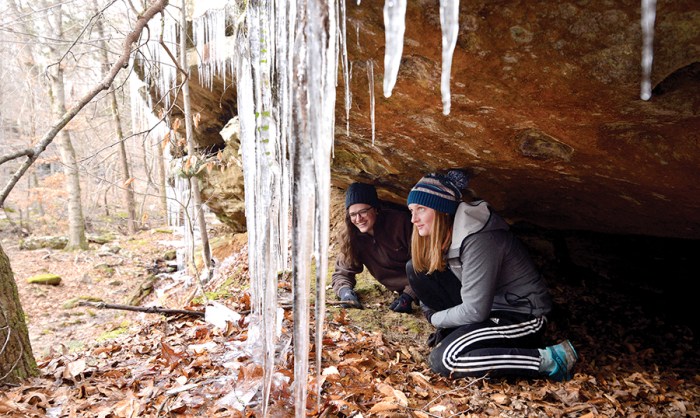
#1 CHOOSE A FUN LOCATION
Crew 365, chartered to the University of Evansville, goes to Shawnee National Forest in Southern Illinois every January. But Shawnee National Forest is a big place — more than 265,000 acres. That means each year they can choose a different trail, and each year is a completely new experience.
Last winter, the group hiked in Lusk Creek Wilderness on the Indian Kitchen and Bear Branch Creek trails, and saw an epic waterfall at Burden Falls Wilderness. It’s an easy enough adventure for the newcomers to handle, but it’s scenic enough to keep things interesting for the veterans.
On this day, it was just warm enough for some of the snow to melt and then refreeze as icicles several feet long.
“It’s absolutely gorgeous,” says Madelyn Reinagel, the crew’s vice president of activities. “It’s really stunning. All of the ice formations just added to it.”
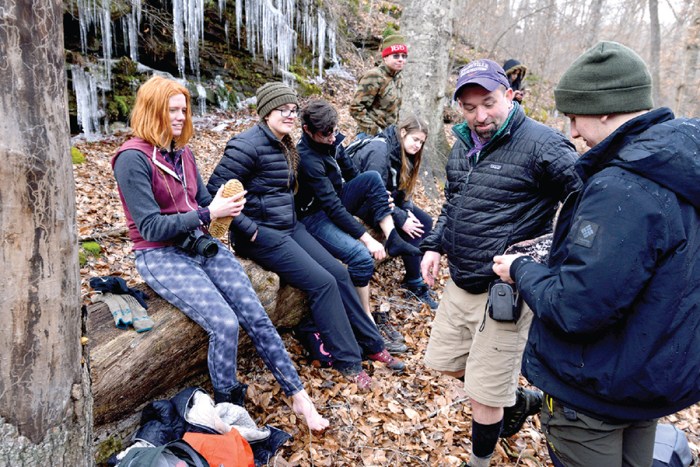
#2 GEAR UP
Having the right stuff is important year-round. It’s extra important in winter.
Get the right winter sleeping bag. Grab the correct noncotton clothing. Don’t leave home without extra pairs of wool socks.Crew 365 helps its crewmates with that.
“As long as you’re a member of the crew, you can borrow any piece of gear you might need.” says Matt Waters, the crew’s vice president of high adventure and also an Eagle Scout. “We bring extra hats along. We bring sleeping bags and pads and tents. If you’re a member, you can check it out for the weekend and bring it back.”

#3 DON’T SWEAT IT (LITERALLY)
Sweating is good when it’s hot. The process of sweat evaporating from your skin sucks the heat off your body and cools you.
When it’s cold, sweating is bad. You want to hold on to that heat. How is it possible to break into a sweat when it’s freezing cold? You’d be surprised.
You start off your hike nice and comfy, but once you start moving, your body heats up.
“We definitely make sure people know they need to dress in layers so they don’t get cold,” crew president Katie Mearns says. “If any of us feel it’s getting warm, we say, ‘Hey, guys, you can take off some layers if you’re getting hot.’ You don’t want them to sweat.”
#4 DRINK UP
Everybody likes drinking water when it’s hot. It takes a special kind of dedication to drink the same amount when it’s cold.
During the summer, moisture exits your body through sweat. In winter, when the air is drier, it comes out through your breath. You know how you can see your breath in the cold air? That’s water your body is losing.
“As we’re walking,” Katie says, “we’ll stop and let everyone catch up and say, ‘Hey, guys, now is a good time to drink some water.’”
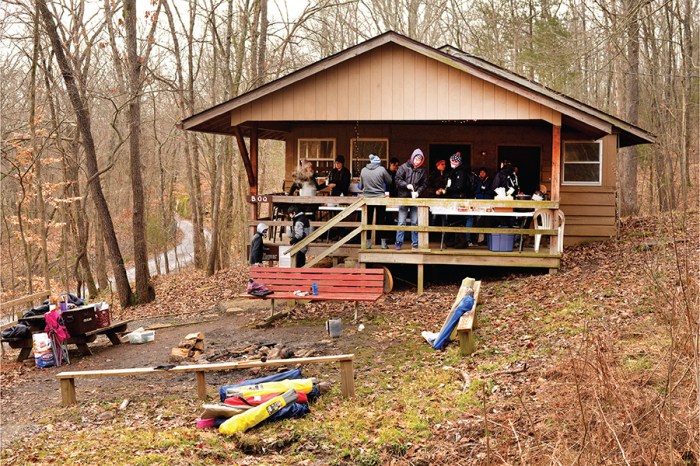
#5 CONSIDER THE CABIN
Normally, Crew 365 sleeps outdoors on their outings. At this event, the forecast called for a nighttime windchill of around 10 degrees. The youth leaders got together and decided those were no conditions for inexperienced campers. They elected instead to reserve an inexpensive rustic cabin.
It wasn’t exactly the Hilton: The cabin had beds but no heater. It was still cold. Just not 10 degrees cold.
“It was very, very basic,” says Tyler Wintermute, another Eagle Scout and the crew’s treasurer. “It sheltered us from the wind. But it still got pretty cold in there.”
The crew spent the night much as they did the day — in layers. Extra blankets if they got cold; if they got too warm, they could easily discard a layer.

#6 CONSIDER THE CAMPFIRE
You can get along fine without a campfire, even when it’s cold. Campfires can char plants, blacken rocks and otherwise ruin the ground.
However, in situations where campfires are appropriate — like in areas with an established campfire ring — there’s nothing like it to bring a group together on a cold night.
“It’s a unique experience. Scouts is one of the only organizations that can provide it,” Matt says. “You’re able to share stories and experiences of things you’ve done in the past. You can reminisce about the previous day. You can really get to know some of the people you’re with.”
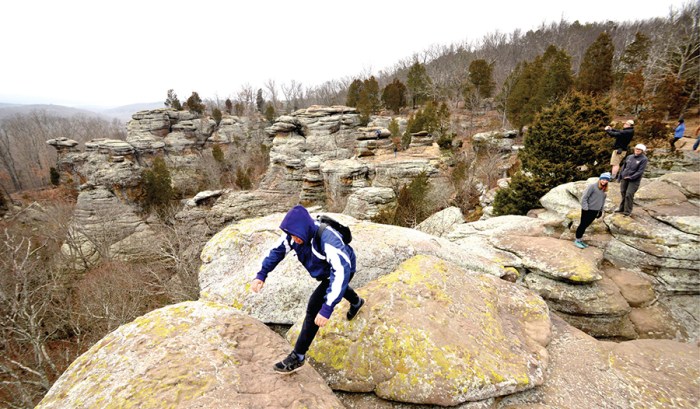
#7 LEAVE NO TRACE
The goal of every outing should be to leave the area in better shape than it was when you got there.
One Crew 365 member took this to the extreme on their latest Shawnee adventure. When he came across a discarded car mat — of all things — in the middle of the woods, he felt like he had no choice.
“We had a talk about Leave No Trace,” Katie says. “If we saw anything that was trash, we picked it up and carried it out with us. So he picked up (the mat) and carried it out with us.”
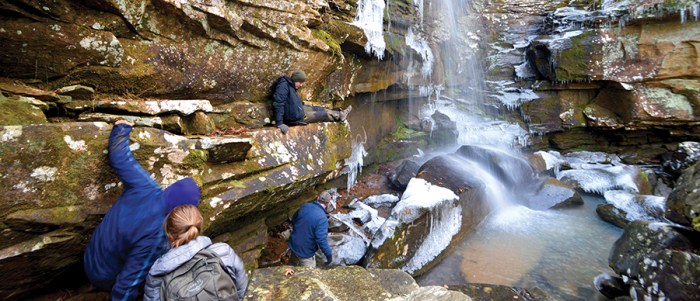
#8 FIND SOMETHING COOL TO SEE
The most famous Garden of the Gods is the National Natural Landmark in Colorado Springs, Colorado. But Garden of the Gods Recreation Area in Shawnee National Forest is just as awe-inspiring, even if it is lesser known.
Scientists say it was the shore of an ancient sea 320 million years ago. Now it’s a series of amazing sandstone rock formations, with incredible views of the surrounding wilderness.
On the final day of their camping trip, Crew 365 hiked the Garden of the Gods Observation Trail.
The trail is only about a quarter-mile long, but it takes time, because you’re walking between — and sometimes hopping over — the rocks.
“It’s the highlight of the trip,” says Spencer Willem, an Eagle Scout and the crew’s vice president of outings. “You can just see forever. It’s an uninterrupted view for miles.”
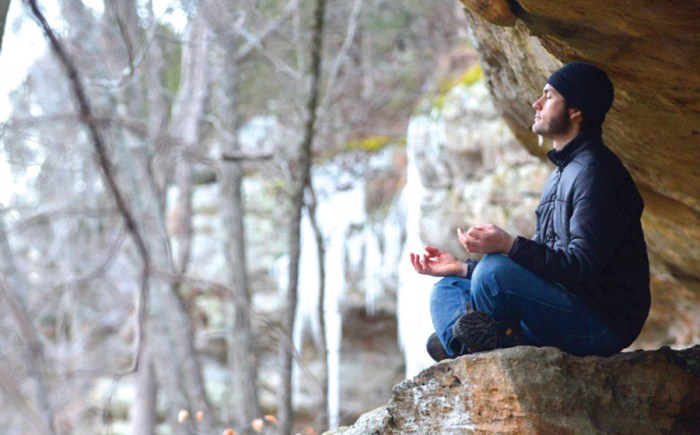
#9 BE COOL (NOT LITERALLY)
Assuming you have the proper equipment, there’s one thing that can make or break your winter hiking experience: your attitude.
Instead of adding a layer, do you complain the first time you start to feel chilly? If so, you could be in for a long weekend.
“At the end, the (inexperienced Venturers) were proud of themselves for powering through the trip and getting through any kind of cold they experienced,” Madelyn says. “It’s a good sense of accomplishment.”

Know Before You Go
Where: Shawnee National Forest, located in the Ozark and Shawnee Hills of Southern Illinois
What: Winter hiking, summer hiking … all kinds of hiking. Plus: camping, cycling, climbing and fishing
When: Anytime, as long as you’re prepared.
Learn more at go.scoutlife.org/shawnee
Glad to see Leave No Trace emphasized. As a Scouter and Leave No Trace Center for Outdoor Ethics Master Educator, this is a positive reinforcement of Scouting and Outdoors Ethics.
I am happy to see Leave No Trace make its way into this article, as well! As an LNT Master Educator Instructor myself, we definitely emphasize outdoor ethics on all of our University of Evansville Venturing Crew outings. We take it so seriously that we actually paid for a couple of our crew members to attend a recent ME course, including Madelyn, who is featured in the video.